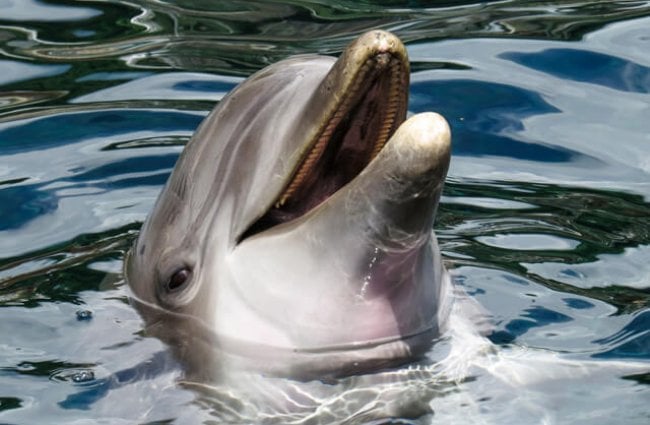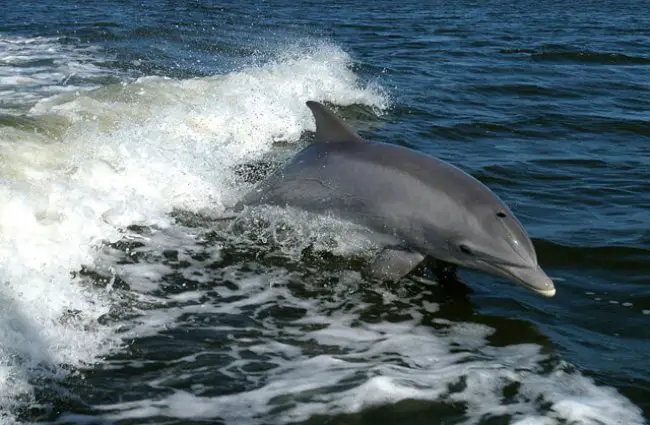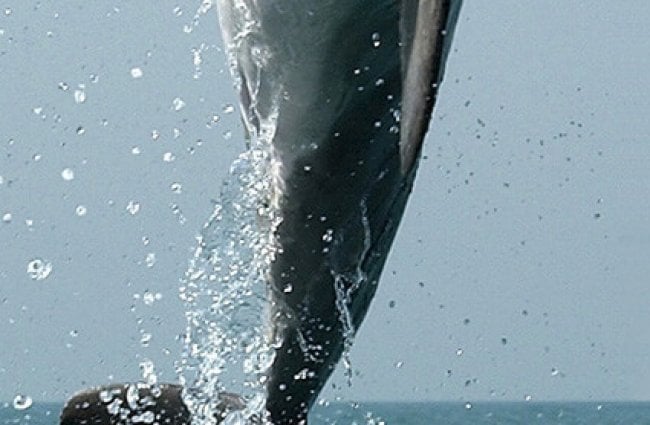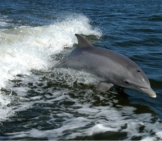Bottlenose dolphins are one of the most easily recognized marine mammals across the world. The vast majority of dolphins seen in zoos and aquariums are bottlenose dolphins. They are an incredibly intelligent mammal, and are capable of learning the meaning of many different hand signals! Read on to learn about the Bottlenose Dolphin.
Description of the Bottlenose Dolphin
Bottlenose dolphins are large, gray marine mammals. A bottlenose dolphin can be between ten and twelve feet long, and can weigh up to 1,100 pounds! Bottlenose dolphins get their name from their distinctive bottle shaped mouth, which is known as a “rostrum.” Dolphins are torpedo shaped to help them move through the water more smoothly. This trait is known as being “hydrodynamic.”
A dolphin’s skin is extremely smooth, and has a rubbery texture similar to a wet hotdog. They have two triangular pectoral flippers, which are similar to a short version of our arms. These are used to steer them through the water.
Their muscular tail, which is known as a “fluke,” is moved in an up-down motion to propel them through the water. Finally, a dolphin has a curved dorsal fin on its back. This dorsal fin is used to keep the animal upright in the water, and is occasionally mistaken for a shark’s fin!
Interesting Facts About the Bottlenose Dolphin
The bottlenose dolphin has many different traits that make it an extremely interesting animal. Read some fun facts you may not know about bottlenose dolphins below.
- Dolphins are Mammals, Not Fish – Even though they live in the ocean, dolphins are not fish. Bottlenose dolphins are marine mammals. They give live birth, feed their babies milk, breathe air, are warm blooded, and even have hair. Baby dolphins are born with soft hair, called “lanugo,” on their rostrums. This hair falls off soon after birth.
- Dolphins Can Navigate Using Sound – Dolphins have good eyesight, but they can also “see” using sound, in a process called “echolocation.” Dolphins emit clicking sounds, and listen for the sound to bounce back off of objects. They use the “echo” from these clicks, to “locate” objects around them, or “echolocate.”
- Dolphins Have Names – Every dolphin has a unique signature whistle that identifies them, just like your name! Dolphins have been seen using another dolphin’s signature whistle to find them. This is exactly how you would call a friend’s name to find out where they are.
Habitat of the Bottlenose Dolphin
Bottlenose dolphins are found in tropical and temperate oceans worldwide. The only habitat they are not found in is polar waters.
Distribution of the Bottlenose Dolphin
In the Pacific Ocean, they are found as far north as Japan, and as far south as Australia. They are also found from southern California to Chile. In the Atlantic Ocean, dolphins are found as far north as Nova Scotia, and as far south as Patagonia. They are also found from Norway to South Africa, and in the Indian Ocean, from South Africa to Australia.
Diet of the Bottlenose Dolphin
Bottlenose dolphins eat a wide variety of fish, crustaceans, squid, and eels. These include herring, capelin, and smelt, to name a few.
Bottlenose Dolphin and Animal Training
The bottlenose dolphin started the movement of positive reinforcement training. Positive reinforcement means giving the animal a reward when they have done the right behavior, rather than punishing them when they do the wrong behavior. Nowadays, positive reinforcement is the only type of training used in zoos and aquariums. Positive reinforcement is also becoming more popular in dog training.
Zoos and aquariums have begun using positive reinforcement training to teach animals how to help in their own care. Dolphins are taught to allow trainers to draw a blood sample, while remaining calm and comfortable. Most adult humans can’t even do that!
Other things they are taught to do include: sliding out of the water onto a scale to be weighed, holding still for physical examinations, and even providing a urine sample (yuck!). All of these behaviors can help the trainers make sure the animal is not getting sick. It can also help them treat the animal if they do.
Bottlenose Dolphin and Human Interaction
Bottlenose Dolphins and humans interact both in the wild and in zoos and aquariums. Some interactions in the wild can be harmful to dolphins. Dolphins fed by boaters can become sick from the food (bait that has been sitting out all day can be covered in bacteria), or begin following boats. A dolphin that interacts with boats frequently is much more likely to get injured by a propeller.
Dolphins and whales can also be disrupted by whale-watching tours. Studies of orcas (a larger species of dolphin) have shown that individuals swim farther when whale-watching boats are out. They swim more to avoid the boats, expending more energy. The more energy an animal uses, the more they need to eat.
Domestication
Bottlenose dolphins have not been domesticated in any way. They are wild animals.
Does Bottlenose Dolphin Make a Good Pet
Unless you are opening your own aquarium, dolphins are virtually impossible to own as a pet.
Bottlenose Dolphin Care
In zoos and aquariums, dolphins are provided with all the food and enrichment (toys and games) they need. The largest dolphins can eat up to 70 lbs. of fish per day! Trainers provide the dolphins with multiple training sessions throughout the day, if the dolphin doesn’t want to participate it simply swims away.
Dolphins also enjoy playing with toys, some toys they get include: buoys, basketballs, footballs, floating toys (big rubber ducky!), and sinking toys.
Behavior of the Bottlenose Dolphin
The bottlenose dolphin loves to engage in play, both in human care and in the wild. In the wild they have been seen riding the waves produced by boats, and interacting with other species. Dolphins have also been known to toss pieces of seaweed in the air, and play keep-away with one another.
Reproduction of the Bottlenose Dolphin
Dolphins begin to reproduce between 5-13 years old, and carry their babies for approximately 12 months. Baby dolphins nurse from their mothers for up to 18 months.
Beliefs, Superstitions, and Phobias About the Bottlenose Dolphin
In Greek mythology, a dolphin swimming near a boat was seen as a good omen. Stories from many cultures recount times when dolphins saved the lives of shipwrecked sailors. These stories sometimes even told of the dolphins protecting the sailors from sharks.











![Red Angus Closeup of a beautiful Red Angus cowPhoto by: U.S. Department of Agriculture [pubic domain]https://creativecommons.org/licenses/by/2.0/](https://animals.net/wp-content/uploads/2020/03/Red-Angus-4-238x178.jpg)












![Red Angus Closeup of a beautiful Red Angus cowPhoto by: U.S. Department of Agriculture [pubic domain]https://creativecommons.org/licenses/by/2.0/](https://animals.net/wp-content/uploads/2020/03/Red-Angus-4-100x75.jpg)

